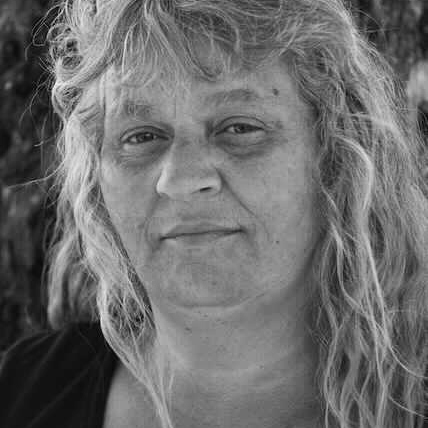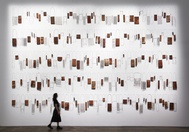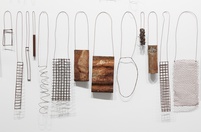Lorraine Connelly-Northey
Waradgerie (Wiradjuri) Country, Narrandera, New South Wales. Waradgerie, Southern Riverine region
2021
Displayed 2021 at Carriageworks

Lorraine Connelly-Northey
Born 1962, Wamba Wamba/Latji Latji/Wadi Wadi Country, Swan Hill, Victoria. Lives and works on Waradgerie (Wiradjuri) Country, Narrandera, New South Wales. Waradgerie, Southern Riverine region
The artistic practice of Lorraine Connelly-Northey is influenced by her western and Aboriginal heritage. She works with abandoned, failed and forgotten materials, such as wire and corrugated iron, products of European settlement sourced from rubbish dumps and farms along her tribal boundaries. Connelly-Northey repurposes these materials into sculptural works, employing Aboriginal weaving techniques and referencing traditional objects, such as coolamons (vessels). Through her work Connelly-Northey addresses history and race, and the importance of safeguarding traditional knowledge.
Artist text
by Emily Johnson
Lorraine Connelly-Northey draws from her knowledge of Waradgerie weaving techniques and the duality of cross-cultural identity to produce distinctive objects that encapsulate both the industrial and the organic. She represents her Waradgerie and Irish heritage, speaking fondly of her childhood in the Mallee and Riverina areas.
The importance of protecting and preserving Aboriginal knowledge and the care of Country is at the forefront of Connelly-Northey’s work for The National 2021, Narrbong Galang (2021). The title of the work is derived from Waradgerie language: narrbong meaning bag or pouch and galang meaning plural. Connelly-Northey explains the significance of language revival for both Aboriginal and non-Aboriginal audiences when titling her work:
You’re educating people and it’s pretty exciting to hear a non-Aboriginal person say narrbong galang, or something like that, or an Aboriginal person for that matter. And I must remind people that just because we have Aboriginal in us, that doesn’t mean we’ve had an opportunity to learn about our culture. It’s just exciting to hear the language in the space. (1)
Taught by her mother, Connelly-Northey developed the required dexterity and patience for weaving at a young age, and later studied advanced weaving techniques with renowned Ngarrindjeri weaver, Yvonne Koolmatrie. (2) She was also inspired by her father’s resourcefulness and her memories of scavenging with him for spare parts in tips and scrap yards. This foundation would go on to become the starting point for her artistic practice, in which discarded scrap metal is amassed by the artist and re-imagined into the iconic narrbong for which she has become renowned.
The narrbong function as demonstrations of the resourcefulness and resilience of Aboriginal artistry and survival within capitalist, industrialised society. With works exhibited in many exhibitions as well as being acquired for public and private collections, Connelly-Northey has gained recognition for her unique approach to weaving and sculpture.
Narrbong Galang evokes strong parallels to the cast-iron columns and steel trusses of the Carriageworks building and its rich industrial history – reimagined and re-purposed. Hundreds of bags, uniquely sized with variations of steel and degrees of corrosion are horizontally aligned across the space, reminiscent of a serial code or lines of sheet music.
Connelly-Northey subverts an iconic item and aesthetic, often associated with natural fibres and organic textures, to produce dissident objects that are rigid and often precarious to hold or touch. She describes the act of collecting materials as ‘taking back Country’, with emphasis on the importance of only taking what is needed. By actively selecting discarded scrap metal she protects the native plants and materials more commonly associated with weaving, while removing the remnants of western agriculture and industry from the landscape. In Connelly-Northey’s work, these remnants are re-contextualised as decolonial and environmentally conscious statements. Narrbong Galang provokes audiences to reflect on whose Country they live on, and the impact their presence could one day leave behind.
(1) Interview between the artist and author, 2021.
(2) Sylvia Kleinert, ‘Clothing the postcolonial body: art, artifacts and action in south eastern Australia’, Craft + Design Enquiry, no.2, 2010, p.46.


